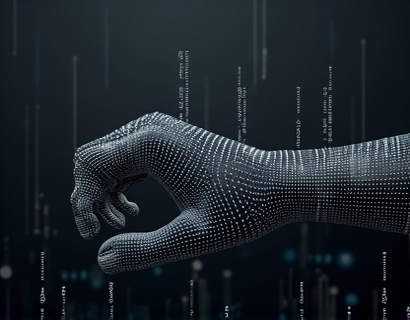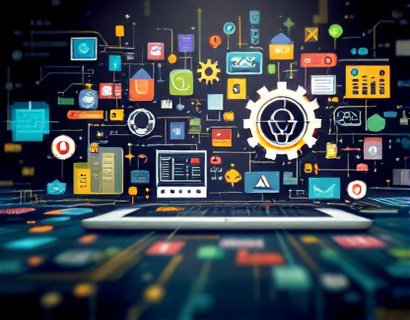Revolutionizing Digital Experiences: The Synergy of Crypto and AI
The intersection of cryptocurrency and artificial intelligence is giving rise to a new era of digital transformation, offering unprecedented opportunities for tech innovators and early adopters. This convergence is not just about integrating two advanced technologies; it's about creating a synergy that redefines how we interact with digital platforms, enhancing security, personalization, and efficiency. As we delve into this topic, we will explore how these technologies are transforming online experiences and empowering users with next-gen solutions.
The Foundations of Cryptocurrency and AI
To understand the transformative power of combining cryptocurrency and AI, it's essential to first grasp the fundamentals of each technology. Cryptocurrency, a digital or virtual currency that uses cryptography for security, operates on a decentralized network known as a blockchain. This decentralized nature ensures transparency, security, and immutability, making it an ideal foundation for trustless transactions and data management.
Artificial intelligence, on the other hand, involves the simulation of human intelligence processes by machines, particularly computer systems. These processes include learning (the acquisition of information and rules for using it), reasoning (using rules to reach approximate or definite conclusions), and self-correction. AI's capabilities range from simple data analysis to complex decision-making, making it a powerful tool for enhancing various aspects of digital experiences.
Enhancing Security with Crypto and AI
One of the most significant benefits of combining cryptocurrency and AI is the enhancement of security measures. Traditional security protocols can be vulnerable to breaches and fraud, but the integration of AI can significantly bolster these defenses. AI algorithms can detect and respond to anomalies in real-time, identifying potential threats before they materialize. For instance, machine learning models can analyze patterns in transaction data to spot suspicious activities, thereby preventing fraudulent transactions.
Moreover, the use of blockchain technology ensures that once data is recorded, it cannot be altered without consensus from the network. This immutability, combined with AI's predictive capabilities, creates a robust security framework. For early adopters and tech innovators, this means a more secure environment for conducting transactions and managing sensitive data, fostering greater trust and adoption of digital solutions.
Personalization and User Experience
The integration of AI in cryptocurrency applications is revolutionizing user experience through advanced personalization. AI algorithms can analyze user behavior, preferences, and historical data to provide tailored recommendations and services. In the context of crypto, this means that users can receive personalized investment advice, curated content, and customized wallet experiences.
For example, an AI-driven platform can analyze market trends and suggest optimal times for buying or selling cryptocurrencies based on a user's risk profile and investment goals. This level of personalization not only enhances user satisfaction but also increases the efficiency of digital interactions, making the overall experience more intuitive and user-friendly.
Smart Contracts and Automated Processes
Smart contracts, self-executing contracts with the terms of the agreement directly written into code, are another area where crypto and AI converge to transform digital experiences. AI can optimize the creation and execution of smart contracts by analyzing complex data sets and predicting outcomes. This ensures that contracts are not only secure but also efficient and adaptable to changing conditions.
For instance, in supply chain management, AI can monitor and analyze data from various sources to ensure that smart contracts trigger the appropriate actions at the right times. This automation reduces manual intervention, minimizes errors, and speeds up processes, providing a seamless experience for all parties involved. Tech innovators can leverage these capabilities to build more reliable and efficient systems, setting them apart in a competitive market.
Decentralized Finance (DeFi) and AI-Driven Innovations
Decentralized Finance (DeFi) is a rapidly growing sector that combines blockchain and AI to create financial services without traditional intermediaries. AI-driven DeFi platforms can offer a range of services, from lending and borrowing to trading and insurance, all powered by smart contracts and enhanced by machine learning algorithms.
AI can analyze market data and user behavior to optimize lending rates, predict market trends, and manage risk. For example, an AI-powered DeFi platform can dynamically adjust interest rates based on real-time market conditions and user demand, ensuring fair and efficient financial transactions. This level of automation and intelligence not only democratizes access to financial services but also provides a more responsive and adaptive user experience.
Enhancing Data Privacy and Ownership
Data privacy and ownership are critical concerns in the digital age, and the combination of crypto and AI offers innovative solutions to these challenges. Blockchain's decentralized nature ensures that users have control over their data, while AI can enhance privacy through advanced encryption and anonymization techniques.
Zero-knowledge proofs, a cryptographic method that allows one party to prove to another that a statement is true without revealing any information beyond the truth of that statement, can be powered by AI to ensure secure and private data transactions. This means that users can verify transactions and data integrity without exposing sensitive information, providing a higher level of privacy and control over personal data.
Building Trust Through Transparency
Transparency is a cornerstone of both cryptocurrency and AI, and their combination can significantly enhance trust in digital platforms. Blockchain's transparent ledger system, combined with AI's ability to provide clear and understandable insights, can help build trust among users. AI-driven tools can analyze blockchain data to provide real-time audits and transparency reports, ensuring that all transactions are above board and verifiable.
For early adopters and tech innovators, this level of transparency is invaluable. It not only builds trust with users but also fosters a community of like-minded individuals who value integrity and accountability. This trust is essential for the widespread adoption of new technologies and the growth of digital ecosystems.
Challenges and Considerations
While the potential of combining cryptocurrency and AI is vast, there are challenges and considerations that must be addressed. One of the primary concerns is the regulatory landscape. As both crypto and AI are still evolving, regulations are often lagging behind, creating uncertainty for developers and users alike. It's crucial for tech innovators to stay informed about regulatory changes and ensure compliance to avoid legal issues.
Another challenge is the technical complexity involved in integrating these technologies. Developing AI algorithms that can effectively interact with blockchain networks requires specialized knowledge and expertise. Collaboration between AI experts and blockchain developers is essential to overcome these technical hurdles and create seamless, user-friendly applications.
Future Prospects and Opportunities
The future of crypto and AI is bright, with numerous opportunities for innovation and growth. As technology continues to advance, we can expect to see more sophisticated applications that further enhance digital experiences. For instance, the integration of AI with quantum computing could lead to breakthroughs in cryptography, making blockchain even more secure and efficient.
For tech innovators and early adopters, the convergence of crypto and AI presents a unique opportunity to be at the forefront of this revolution. By embracing these technologies, they can develop cutting-edge solutions that not only solve current problems but also anticipate future needs. The potential for creating transformative digital experiences is immense, and those who lead the way will be well-positioned to shape the future of technology.
In conclusion, the combination of cryptocurrency and AI is not just a technological trend but a fundamental shift in how we approach digital interactions. By leveraging the strengths of both technologies, we can create more secure, personalized, and efficient systems that empower users and drive digital transformation. As we continue to explore this exciting frontier, the possibilities are endless, and the impact on the digital world will be profound.











































